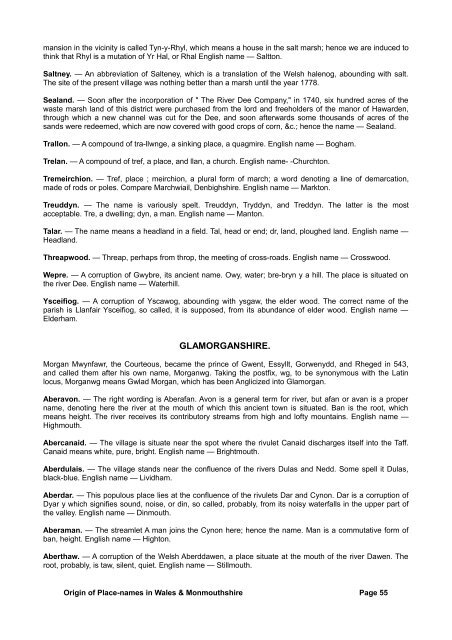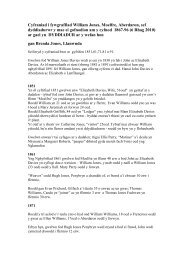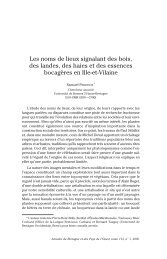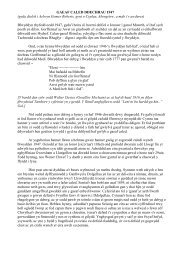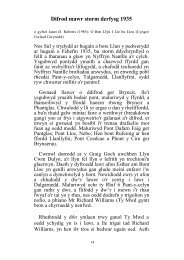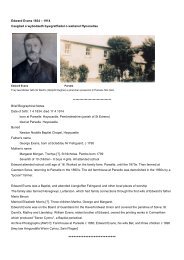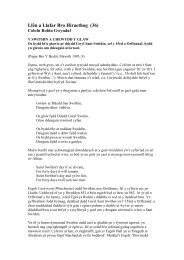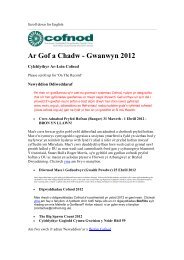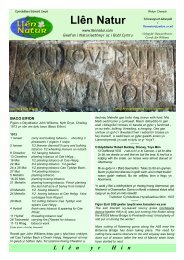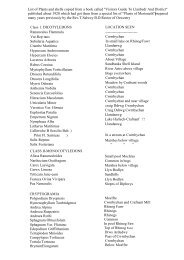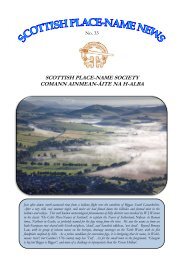mansion <strong>in</strong> <strong>the</strong> vic<strong>in</strong>ity is called Tyn-y-Rhyl, which means a house <strong>in</strong> <strong>the</strong> salt marsh; hence we are <strong>in</strong>duced toth<strong>in</strong>k that Rhyl is a mutation <strong>of</strong> Yr Hal, or Rhal English name — Saltton.Saltney. — An abbreviation <strong>of</strong> Salteney, which is a translation <strong>of</strong> <strong>the</strong> Welsh halenog, abound<strong>in</strong>g with salt.The site <strong>of</strong> <strong>the</strong> present village was noth<strong>in</strong>g better than a marsh until <strong>the</strong> year 1778.Seal<strong>and</strong>. — Soon after <strong>the</strong> <strong>in</strong>corporation <strong>of</strong> " The River Dee Company," <strong>in</strong> 1740, six hundred acres <strong>of</strong> <strong>the</strong>waste marsh l<strong>and</strong> <strong>of</strong> this district were purchased from <strong>the</strong> lord <strong>and</strong> freeholders <strong>of</strong> <strong>the</strong> manor <strong>of</strong> Hawarden,through which a new channel was cut for <strong>the</strong> Dee, <strong>and</strong> soon afterwards some thous<strong>and</strong>s <strong>of</strong> acres <strong>of</strong> <strong>the</strong>s<strong>and</strong>s were redeemed, which are now covered with good crops <strong>of</strong> corn, &c.; hence <strong>the</strong> name — Seal<strong>and</strong>.Trallon. — A compound <strong>of</strong> tra-llwnge, a s<strong>in</strong>k<strong>in</strong>g <strong>place</strong>, a quagmire. English name — Bogham.Trelan. — A compound <strong>of</strong> tref, a <strong>place</strong>, <strong>and</strong> llan, a church. English name- -Churchton.Tremeirchion. — Tref, <strong>place</strong> ; meirchion, a plural form <strong>of</strong> march; a word denot<strong>in</strong>g a l<strong>in</strong>e <strong>of</strong> demarcation,made <strong>of</strong> rods or poles. Compare Marchwiail, Denbighshire. English name — Markton.Treuddyn. — The name is variously spelt. Treuddyn, Tryddyn, <strong>and</strong> Treddyn. The latter is <strong>the</strong> mostacceptable. Tre, a dwell<strong>in</strong>g; dyn, a man. English name — Manton.Talar. — The name means a headl<strong>and</strong> <strong>in</strong> a field. Tal, head or end; dr, l<strong>and</strong>, ploughed l<strong>and</strong>. English name —Headl<strong>and</strong>.Threapwood. — Threap, perhaps from throp, <strong>the</strong> meet<strong>in</strong>g <strong>of</strong> cross-roads. English name — Crosswood.Wepre. — A corruption <strong>of</strong> Gwybre, its ancient name. Owy, water; bre-bryn y a hill. The <strong>place</strong> is situated on<strong>the</strong> river Dee. English name — Waterhill.Ysceifiog. — A corruption <strong>of</strong> Yscawog, abound<strong>in</strong>g with ysgaw, <strong>the</strong> elder wood. The correct name <strong>of</strong> <strong>the</strong>parish is Llanfair Ysceifiog, so called, it is supposed, from its abundance <strong>of</strong> elder wood. English name —Elderham.GLAMORGANSHIRE.Morgan Mwynfawr, <strong>the</strong> Courteous, became <strong>the</strong> pr<strong>in</strong>ce <strong>of</strong> Gwent, Essyllt, Gorwenydd, <strong>and</strong> Rheged <strong>in</strong> 543,<strong>and</strong> called <strong>the</strong>m after his own name, Morganwg. Tak<strong>in</strong>g <strong>the</strong> postfix, wg, to be synonymous with <strong>the</strong> Lat<strong>in</strong>locus, Morganwg means Gwlad Morgan, which has been Anglicized <strong>in</strong>to Glamorgan.Aberavon. — The right word<strong>in</strong>g is Aberafan. Avon is a general term for river, but afan or avan is a propername, denot<strong>in</strong>g here <strong>the</strong> river at <strong>the</strong> mouth <strong>of</strong> which this ancient town is situated. Ban is <strong>the</strong> root, whichmeans height. The river receives its contributory streams from high <strong>and</strong> l<strong>of</strong>ty mounta<strong>in</strong>s. English name —Highmouth.Abercanaid. — The village is situate near <strong>the</strong> spot where <strong>the</strong> rivulet Canaid discharges itself <strong>in</strong>to <strong>the</strong> Taff.Canaid means white, pure, bright. English name — Brightmouth.Aberdulais. — The village st<strong>and</strong>s near <strong>the</strong> confluence <strong>of</strong> <strong>the</strong> rivers Dulas <strong>and</strong> Nedd. Some spell it Dulas,black-blue. English name — Lividham.Aberdar. — This populous <strong>place</strong> lies at <strong>the</strong> confluence <strong>of</strong> <strong>the</strong> rivulets Dar <strong>and</strong> Cynon. Dar is a corruption <strong>of</strong>Dyar y which signifies sound, noise, or d<strong>in</strong>, so called, probably, from its noisy waterfalls <strong>in</strong> <strong>the</strong> upper part <strong>of</strong><strong>the</strong> valley. English name — D<strong>in</strong>mouth.Aberaman. — The streamlet A man jo<strong>in</strong>s <strong>the</strong> Cynon here; hence <strong>the</strong> name. Man is a commutative form <strong>of</strong>ban, height. English name — Highton.Aberthaw. — A corruption <strong>of</strong> <strong>the</strong> Welsh Aberddawen, a <strong>place</strong> situate at <strong>the</strong> mouth <strong>of</strong> <strong>the</strong> river Dawen. Theroot, probably, is taw, silent, quiet. English name — Stillmouth.Orig<strong>in</strong> <strong>of</strong> Place-<strong>names</strong> <strong>in</strong> Wales & Monmouthshire Page 55
Abertridwr. — Tridwr, three waters, so-called from <strong>the</strong> situation <strong>of</strong> <strong>the</strong> village at <strong>the</strong> confluence <strong>of</strong> threebrooks. English name — Watermouth.Abernant. — A brook called Nantygroes flows through <strong>the</strong> <strong>place</strong>, <strong>and</strong> empties <strong>in</strong>to <strong>the</strong> Cynon near Tir-yfounder.English name — Brookmouth.Aberfan. — Ban, high; Banau Bryche<strong>in</strong>iog, <strong>the</strong> Brecknock Beacons. Fan is a brook that falls <strong>in</strong>to <strong>the</strong> riverTaff at <strong>the</strong> <strong>place</strong>. Two farmhouses also bear <strong>the</strong> name. The village is also called Ynys Owen, from a farm <strong>of</strong>that name. The railway station has been designated Merthyr Vale, <strong>and</strong> henceforth, <strong>the</strong> village will, doubtless,be known by <strong>the</strong> same name.Alltwen. — Allt, a cliff, <strong>the</strong> side <strong>of</strong> a hill; wen r fem<strong>in</strong><strong>in</strong>e <strong>of</strong> gwyn, white. The name is <strong>in</strong> correspondence with<strong>the</strong> situation <strong>of</strong> <strong>the</strong> village, be<strong>in</strong>g on a hill-side. English name— Whitehill.Abwrth<strong>in</strong>. — Perhaps a corruption <strong>of</strong> Aberih<strong>in</strong>, which implies a <strong>place</strong> <strong>of</strong> sacrifices, so called, probably, from<strong>the</strong> supposition that Druidical sacrifices were <strong>of</strong>fered here. English name — Altarton.Abercenffig. — Cenffig is a contraction <strong>of</strong> Cefn-y-Figy so called from <strong>the</strong> situation <strong>of</strong> <strong>the</strong> <strong>place</strong> on a ridge <strong>of</strong>ground above a bog. It is generally believed that this ancient town was <strong>in</strong>undated by <strong>the</strong> sea about <strong>the</strong>middle <strong>of</strong> <strong>the</strong> sixteenth century, <strong>and</strong> that <strong>the</strong> present village was built near or on <strong>the</strong> <strong>place</strong> <strong>of</strong> <strong>in</strong>undation.English name — Bogton.Abercwmboy. — Some th<strong>in</strong>k <strong>the</strong> name is a corruption <strong>of</strong> Abercwmybwci: cum, a. d<strong>in</strong>gle; y, <strong>the</strong>; bwci abugbear, hobgobl<strong>in</strong>. It was <strong>the</strong> va<strong>in</strong> belief <strong>of</strong> <strong>the</strong> ab<strong>orig<strong>in</strong></strong>es <strong>of</strong> this valley that a hobgobl<strong>in</strong> once haunted <strong>the</strong><strong>place</strong>- Bwci was reduced to bo <strong>and</strong> ultimately y was added; hence <strong>the</strong> name <strong>in</strong> its present form. Perhaps <strong>the</strong>right word<strong>in</strong>g is Aber-cwm-bwdau. Bwa is <strong>the</strong> Welsh for bow. Bwa a saeth r bow <strong>and</strong> arrow. We f<strong>in</strong>dCwmbwa <strong>in</strong> Cardiganshire ; <strong>and</strong> Brynbo (Bryn-bwa) <strong>and</strong> Cwm Bowydd (Cwra-bwa-gwydd) <strong>in</strong> North Wales,where bo is a contraction <strong>of</strong> bwa. Perhaps <strong>the</strong> <strong>place</strong> was once noted for its abundance <strong>of</strong> trees <strong>of</strong> which ourforefa<strong>the</strong>rs made <strong>the</strong>ir bows. The village is also called Cap Coch, red cap. Tradition has it that an eccentricpublican <strong>and</strong> cock-fighter <strong>in</strong> remote times always wore a red cap on a cock-fight<strong>in</strong>g day, <strong>and</strong> that <strong>the</strong> <strong>place</strong> isso called from that circumstance. English name — Bowcombe, or Bocombe.Abergwynfi. — From a farm so named. It was once called Trejenk<strong>in</strong>, <strong>in</strong> honour <strong>of</strong> Mr. Jenk<strong>in</strong>s, Gelli farm. Itwas also called Blaenavan, from its situation at <strong>the</strong> source <strong>of</strong> <strong>the</strong> river Avan. Gwynfi is a corruption <strong>of</strong> gwynfai,white or blessed pla<strong>in</strong>. English name — Whitmouth.Bedl<strong>in</strong>og. — From an old farm so named. The word is probably a compound <strong>of</strong> bedw, birch tree, <strong>and</strong> lla<strong>in</strong>, aslip, or long narrow <strong>place</strong>. Lla<strong>in</strong> o dir, a slip <strong>of</strong> l<strong>and</strong>, a small field. Or <strong>the</strong> right word<strong>in</strong>g may be Bedw-Imyn,birchgrove. The village is also called Cwmfel<strong>in</strong>, from an old mill <strong>in</strong> <strong>the</strong> <strong>place</strong>. It is also popularly called Colly,from a farm so called; col, any' project<strong>in</strong>g body, a sharp hillock; <strong>and</strong> It-llc, <strong>place</strong>. English name — Bircham.Black Pill. — Probably from <strong>the</strong> blackened stumps <strong>of</strong> a submerged forest, which are to be seen all along <strong>the</strong>shore.Blaengwrach. — The village is situated at <strong>the</strong> extreme end <strong>of</strong> <strong>the</strong> Neath Vale, near <strong>the</strong> source (blaen) o <strong>the</strong>rivulet Gwrach; hence <strong>the</strong> name. Gwrach may be a compound <strong>of</strong> cwr, extremity, <strong>and</strong> dch, river, signify<strong>in</strong>g ariver flow<strong>in</strong>g at <strong>the</strong> extreme end <strong>of</strong> a vale. English name — Nookton.Broughton. — From barrow, a sepulchral mound <strong>of</strong> great antiquity formed <strong>of</strong> earth or stones. Stone barrowsare called cairns <strong>in</strong> Scotl<strong>and</strong>. Several tumuli or barrows were found on each side <strong>of</strong> <strong>the</strong> road from LantwitMajor to Ewenny; hence <strong>the</strong> name. English name — Barrowton .Bodr<strong>in</strong>gallt. — Bod, a dwell<strong>in</strong>g-<strong>place</strong>; r<strong>in</strong>gallt is variously derived. Some are <strong>of</strong> op<strong>in</strong>ion it is a corruption <strong>of</strong>rh<strong>in</strong>gyll, a summoner, found<strong>in</strong>g <strong>the</strong>ir reasons upon <strong>the</strong> supposition that Cadwgan y Fwyall, <strong>the</strong> summoner,took up his abode here. We ra<strong>the</strong>r th<strong>in</strong>k it is a corruption <strong>of</strong> reynallt, a fox, a reynard. The valley was noted <strong>in</strong>olden times for fox-hunt<strong>in</strong>g, as <strong>the</strong> follow<strong>in</strong>g extract shows: — "1752, kill<strong>in</strong>g a fox whelp, 2s. 6d. 1819, paidfor kill<strong>in</strong>g a fox, 5s." English name — Foxham.Blaen Rhondda. — So called from a farmhouse bear<strong>in</strong>g <strong>the</strong> name, <strong>and</strong> also <strong>the</strong> village is situated near <strong>the</strong>source <strong>of</strong> <strong>the</strong> river Rhondda. Blaen means <strong>the</strong> forepart <strong>of</strong> anyth<strong>in</strong>g, <strong>and</strong> here <strong>the</strong> spr<strong>in</strong>g <strong>of</strong> <strong>the</strong> river. EnglishOrig<strong>in</strong> <strong>of</strong> Place-<strong>names</strong> <strong>in</strong> Wales & Monmouthshire Page 56
- Page 1 and 2:
HANDBOOK OF THE ORIGIN OF PLACE-NAM
- Page 3 and 4:
§ § § § §The Author begs to st
- Page 5 and 6:
pitiful cries of the railway offici
- Page 7 and 8: Bishop Percy says that "in England,
- Page 9 and 10: The city of Chester is still popula
- Page 11 and 12: There's Cumwhitton, Cumwhinton, Cum
- Page 13 and 14: Llwyn in its primary' sense means a
- Page 15 and 16: PLACE-NAMES IN WALES.Wales. — The
- Page 17 and 18: Church are generally dedicated to e
- Page 19 and 20: think he was a contemporary of St.
- Page 21 and 22: Rhosbeirio. — Rhos, a moor, a dry
- Page 23 and 24: of Brecknock," states that this vic
- Page 25 and 26: Cam cnwir ef Cwmdu,Cwm gwyn yw & n
- Page 27 and 28: Penderyn. — A corruption probably
- Page 29 and 30: Ardudwy. — Ar, upon or above; tud
- Page 31 and 32: to mark its pre-eminence over the o
- Page 33 and 34: Some think that eirw is a corruptio
- Page 35 and 36: present form — Caerfyrddin.Abergw
- Page 37 and 38: place of refuge; hence the name. En
- Page 39 and 40: Llansawyl. — The church was dedic
- Page 41 and 42: eject. The village took its name fr
- Page 43 and 44: house, and attempted to kill an inf
- Page 45 and 46: Gwydir. — Prima facie one may tak
- Page 47 and 48: Nefyn. — The church was probably
- Page 49 and 50: DENBIGHSHIRE.Anglicized form of Din
- Page 51 and 52: Llangollen. — From Collen, a sain
- Page 53 and 54: hands into their pockets to pay a c
- Page 55 and 56: Cefn. — The name signifies a ridg
- Page 57: Maesgarmon. — Named in honour of
- Page 61 and 62: it is said, was originally built by
- Page 63 and 64: Cwmllynfell. — Cwm, a narrow vale
- Page 65 and 66: Gwarycaeau. — Gwdr, the nape of t
- Page 67 and 68: means a cultivated region, a vale,
- Page 69 and 70: Penrhiwfer.- Pen, head, top; rhiw,
- Page 71 and 72: Port Talbot. — So called in 1835
- Page 73 and 74: Trealaw. — This appellation was g
- Page 75 and 76: Aberdyfi. — So called from its si
- Page 77 and 78: Llanddwywe. — From Dwywau, a desc
- Page 79 and 80: Crickhowell and some in the directi
- Page 81 and 82: Griffithstown. — This village was
- Page 83 and 84: and gwy, water. Treiddiod troth tna
- Page 85 and 86: derive Tintern from din, fortified
- Page 87 and 88: Caersws. — It appears that the Ro
- Page 89 and 90: English name — Ervylton.Llanymech
- Page 91 and 92: Angle. — Probably from the angle-
- Page 93 and 94: Gellyswick. — Another hybrid. Gel
- Page 95 and 96: that the two rivers in their flowin
- Page 97 and 98: ecame the bishop of the see, and wa
- Page 99 and 100: earth formerly stood on a summit on
- Page 101 and 102: Pilleth. — A corruption of pwll,
- Page 103 and 104: Howells, Rev. J., Mountain AshHowel
- Page 105 and 106: Williams, D., PenywernWilliams, Rev


